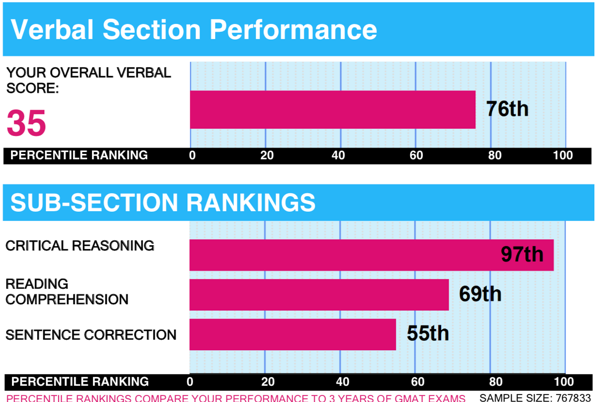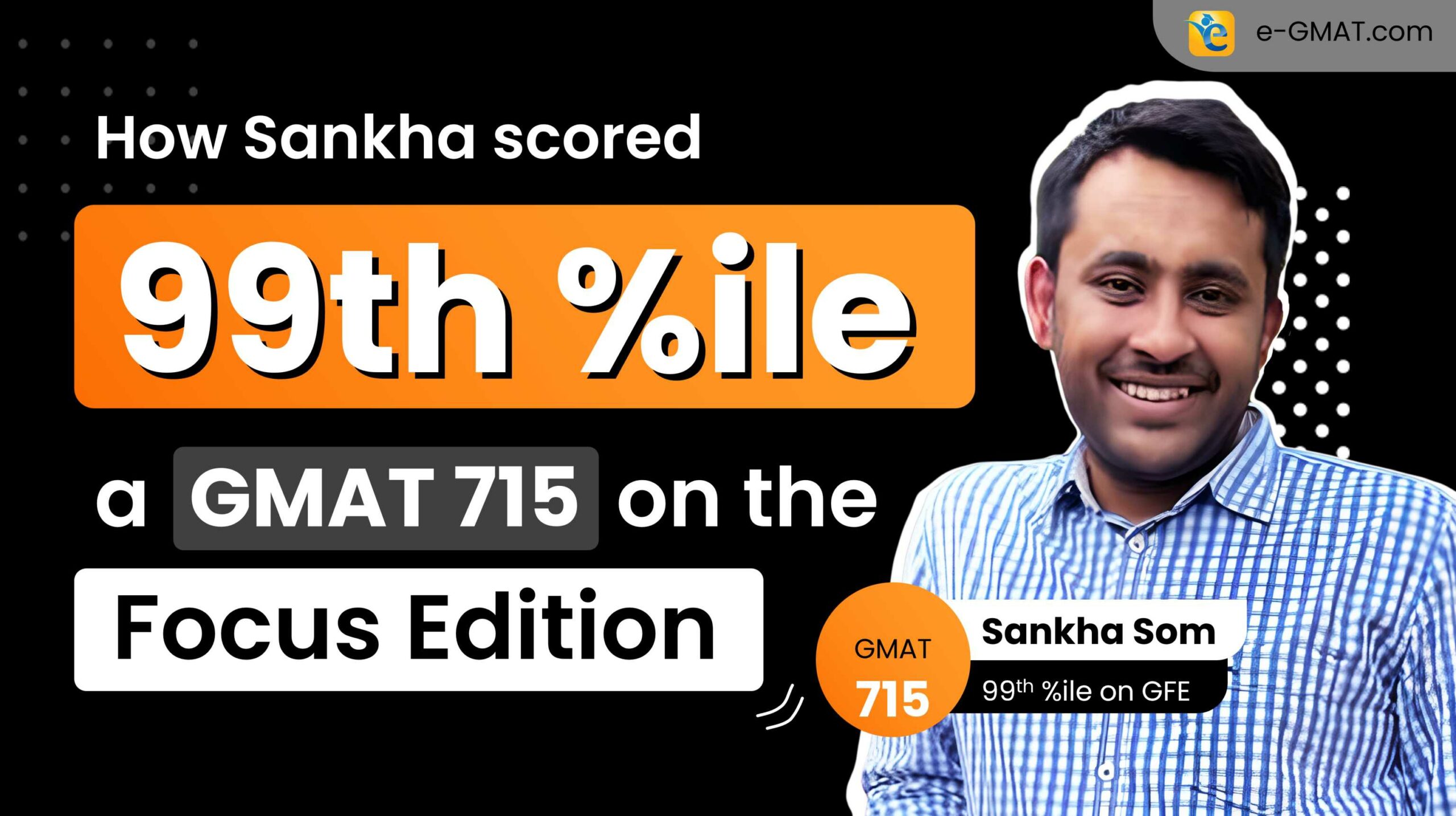Once you are done with all GMAT sections, those few seconds of anticipation when you wait for your score to appear on the screen, feel like a lifetime. You wonder, will your score cause elation or a sigh of disappointment? What will be your next steps if you get your target GMAT score? What will be your strategy, if you don’t? Will you apply in Round 1 or will you have to postpone to Round 2 or Round 3 of the MBA application?
Your mind is constantly in motion, preparing itself for the inevitable. You look at your screen and there is your GMAT score, lower than what you targeted. Feeling disappointed, you get up and leave for your place. On your way back, you are deep in your thoughts wondering, where you are headed. Life hasn’t turned out quite the way you wanted it to be. Eventually, you start thinking about retaking the GMAT.

If you are someone who has felt all that written in the above paragraph, you are not alone. Take a deep breath and a day off, if needed. Utilize that day to rid yourself of fear, stress, or anxiety that this experience might have caused. Think about the positive aspects of your last GMAT attempt. You have already taken the test, at least once. So, you already know what to expect in your GMAT retake. You just have to plan well for your GMAT retake and implement your strategy to achieve your target score.
If test anxiety gets the better of you during the test, read the following article on how to tackle GMAT Anxiety.
We have divided this article on ‘Retaking the GMAT’ into two parts. First, we’ll explain the stepwise strategy for the GMAT retake and then we’ll help you reinforce this strategy by applying it to a real success story. So, let’s begin.
5 steps of retaking the GMAT:
- Step 1 – Identify gaps per your target GMAT score
- Step 2 – Analyze your previous attempt’s ESR
- Step 3 – Estimate the time you need to prepare
- Step 4 – Create a study plan
- Step 5 – Track your improvement

Step 1 – Identify gaps per your target GMAT score
This step is the first and most important step. This is where you decide whether you wish to focus on leveraging your strong section or on improving your weaker section. Moreover, you define the scope of the improvement as well.

For example, if you scored a 670 (Q49, V33) on your last GMAT and your target score is 750, you have to decide through which Quant-Verbal score combination you should target to achieve it. Below are 3 combinations.
| 750 on the GMAT | |
| Q51 (96%ile) | V40 (90%ile) |
| Q50 (85%ile) | V42 (96%ile) |
| Q49 (74%ile) | V45 (99%ile) |
The greatest scope for improvement is in the Verbal section. The first instinct would tell you to target Q51, V40 combination. But think for a moment. The amount of effort you would have to put in to improve from Q49 to Q51 will be almost similar to improve from V33 to V40.
Why? Because, for a Q51, you have to develop a very high ability level and perform exceptionally well on the test day. Since you have limited time for your retake, it’s better to develop that section where the scope for improvement is more.
Still unsure about your retake strategy? Attend our free GMAT Strategy Webinar and get expert advice and feedback about your GMAT attempt.
Once you decide your target Quant Verbal score combination, now identify the gaps. To achieve this, assess your sub-section percentiles.
This will be your next step – Analyzing your ESR.
Step 2 – Analyze your Enhanced Score Report (ESR)
The Enhanced Score Report presents you with meaningful information on your performance in your last GMAT attempt.

ESR analysis will help you identify the section or sub-section with low ability level. Note that we have used the word ‘ability’ here and not ‘accuracy’.
Learn how to analyze an ESR in 3 steps. Moreover, GMAC has introduced a new ESR a few months back. Take a look at the new section added in the new ESR.

Ability, not accuracy – Your GMAT score is dependent on your ability level and not your accuracy.
Why? Because GMAT is an adaptive test and it gauges your ability to tackle difficult questions rather than your accuracy in answering questions.
To understand this step better read the application of this step in the case study we have selected.
Step 3 – Estimate the time you need to prepare
Now that you know your current score and the target score, the next step is to estimate the time required to reach your target ability level. If you use a data-driven online course for preparation you need 7 hours for every 10-point improvement as compared to 12 hours if you use books. This is because online courses are more engaging and provide active feedback.

This time estimate does not work if you are extremely weak in a topic. In that case, you need 25% additional time. Let’s call this Confidence Building Time (CBT).
Note – It’s not about completing the course but improving your competence level. The extent of score improvement depends on the extent to which you master the application of content. Mastering application requires revising the same course material multiple times, understanding the nuances, and ensuring that you don’t make the same mistakes again like Rhea (GMAT 760) did.
Time required (in hours) = [Target GMAT Score – Starting GMAT Score] X [ 7/10] X [1+CBT]
Where:
- Target GMAT Score = final score that you desire
- Starting GMAT score = Starting score on an official mock test
- 7/10 = 7 hours of effort for every 10-point score improvement
- CBT = Confidence Building Time factor; its value can be 0.0 or 0.25
Learn by doing – Why don’t you try calculating the time required to prepare from 670 to 750? Leave your answer in the comments section.
Once you calculate the estimated time, allocate that time between Quant prep, Verbal prep, and mock tests. Devote 50% – 60% of the time on the section where the scope of improvement is the greatest.
While the above formula requires manual inputs, we have created an interactive Personalized Study Planner tool to help you create your own GMAT Study Plan in under 5 minutes.
Here are the features of this GMAT study plan tool and here is the link to the PSP tool itself.
Step 4 – Create a GMAT study plan
At this point, you need to decide
- Which section to study first – Verbal or Quant and what sequence to follow within a section?
- Where to spend time within Verbal and in Quant?
- Frequency to track improvement and how?
To understand this step better read the application of this step in the case study we have selected.
Step 5 – Tracking your Improvement
The best way to track improvement is by using ability quizzes. Ability quizzes provide much more accurate ability estimates than mocks do.
![]()
The best thing – in addition to providing a reliable estimate of your ability, ability quizzes also provide useful insights into the areas to focus on to improve your ability to the next level. Hence, it is not surprising that e-GMAT’s Scholaranium is rated higher than GMAT Prep mock tests on GMAT Club.
Application of the 5-step GMAT Retake Strategy on a case study
Now, that you have read the theoretical part, let’s apply this 5-step strategy to the retake strategy of Nishant. We have taken the data from his debrief.
Nishant took the GMAT 5 times and ultimately scored a 740. His GMAT journey is as follows:
| GMAT Attempt | Score |
| First Attempt | 570 (Q41, V27) |
| Second Attempt | 630 (Q48, V27) |
| Third Attempt | 690 (Q49, V34) |
| Fourth Attempt | 690 (Q48, V35) |
| Fifth Attempt | 740 (Q49, V41) |
We will apply this retake strategy between his fourth and fifth attempt because that is when he achieved his target GMAT score
Step 1
Nishant explains in his debrief that being from a very competitive pool (Indian Engineer), he needed at least 720 on the GMAT. A good GMAT score is at least 20+ points more than the average of the incoming batch. So, to get into a top business school, 740 is a good GMAT score.
Update – Nishant received an admit from Columbia Business School
In Nishant’s case, Verbal had been his Achilles’ heel. So, he has a bigger scope for improvement in Verbal Section. On the other hand, Quant is his strong section and he needs to at least maintain his current ability.
He could have scored 740 on the GMAT with the following Quant and Verbal scaled scores-
| 740 on the GMAT | |
| Q51 (96%ile) | V39 (88%ile) |
| Q49 (85%ile) | V41 (94%ile) |
| Q48 (74%ile) | V44 (98%ile) |

As per his debrief, he had 3 weeks between his fourth and fifth attempt. A Q49, V41 as the target Quant and Verbal Percentiles makes much more sense than any other Quant-Verbal score. This is the most ideal Quant Verbal combination for him because improving from Q48 to Q50 or from V35 to V40 would require the same amount of effort. Therefore, it is better to work on Verbal as the scope of improvement is more.
If you have already begun your GMAT Journey, this article contains helpful tips on how to structure your preparation in the last 25 days of your GMAT Journey.
Step 2
The next step is to identify his target Sub-sectional (CR, RC, and SC) percentiles in the Verbal Section. To understand this part, let’s take a look at his CR, RC, and SC percentiles from his fourth attempt using his ESR.

We can clearly see that CR is his strong section, but he is average in RC and weak in SC sub-sections. It’s clear that he has application gaps in RC and conceptual gaps in SC.
He could target the following Verbal Sub-section percentiles for a V41-
|
V41 |
||
| SC (%ile) | RC (%ile) | CR (%ile) |
| 90 | 77 | 95 |
| 84 | 84 | 95 |
| 75 | 93 | 70 |
So, the Verbal preparation can be SC heavy or RC heavy in Nishant’s case. Improving in SC will take less time as compared to RC because concepts in SC are limited and more structured which makes SC easier to learn. Therefore, Nishant should have focused on SC and he did exactly that.
Take a look at Nishant’s ESRs for his fourth and fifth attempts which proves that the GMAT is a test of ability and not accuracy.
- Nishant answered 9 questions incorrectly in his fourth attempt and scored a V35. But he scored a V41 in his fifth attempt despite answering 7 questions incorrectly.
- Because in his fifth attempt he maintained his accuracy level in the initial 15 questions. By doing this, the test gauged his ability level as high and started throwing difficult questions at him.

One more insight that an ESR can give is the amount of time spent in each block. Take a look at Nishant’s Average Time Per Response for his fourth attempt.

He spent 2 minutes and 2 minutes 35 seconds on each question of the first and second blocks respectively. Moreover, he spent more time on wrong questions, which means he wasted around 17 minutes in Block 1 and 2 combined.
This could be because he got stumped on SC questions in Block 1 and 2. Therefore, it became more important for him to work on SC sub-section for his 5th attempt.
Attend our Webinar on GMAT SC strategy and learn how to ace 700+ level GMAT SC questions with ease.
Step 3
For Nishant the time required to prepare would be as follows:
Time Required = [740-690] x [7/10] x 1.25 (He is weak in SC and RC, therefore, CBT is factored in) ~ 45 hours
Nishant would have required around 63 hours if he had prepared using books.
Nishant had 3 weeks to prepare for his fifth attempt and 45 hours of preparation could be managed easily in this time frame.
Allocating Time between Quant and Verbal
These 44 hours used need to be allocated between Quant and Verbal. Considering the target Quant and Verbal scores, Nishant will need to invest approx. 27 hours in Verbal and 8 hours in Quant. The remaining 10 hours are reserved for mocks.
Step 4
Strategy for Quant Section – Maintaining Ability Level
He needs to maintain his Quant ability level by revising concepts and practicing on Scholaranium. As his current percentile and target percentile are the same, he should not use more than 8 hours to complete this activity.
Strategy for Verbal Section – Ace CR and SC section
Suggested Verbal sub-sectional percentile required to score V41. Based on these breakups, two strategies can be made.
| V41 | ||
| SC (%ile) | RC (%ile) | CR (%ile) |
| 90 | 77 | 95 |
| 84 | 84 | 95 |
Strategy 1 – He should start with SC and build his ability level to 90 percentile. Then move on to RC and build his ability till 80 percentile and revise CR to maintain his ability above 95 percentile.
Strategy 2 – On the other hand, he could build his ability in both SC and RC between 80 and 90 percentile and maintain his RC ability at 95 percentile.
But Strategy 1 is better than Strategy 2 because it is less time consuming to improve ability in SC as compared to RC. Take a look at the comparison of Nishant’s Verbal percentiles for V35 and V41. He improved the most in SC from 55 percentile to 94 percentile.
| V35 | V41 | |
| CR | 97 %ile | 94 %ile |
| RC | 69 %ile | 77 %ile |
| SC | 55 %ile | 94 %ile |
For any strategic advice for GMAT or MBA Admissions, write to us at acethegmat@e-gmat.com. Sign up for a free trial and get unlimited access to concept files, live sessions, and practice questions.
Step 5
Nishant extensively used Scholaranium to take ability quizzes. Scholaranium gave him precise information about his weak topics and he practiced to improve upon them. That is how he tracked his improvement which made him confident about his preparation. The result was him getting a score of 740 on the GMAT.
Start your preparation with this GMAT Retake Strategy
Now that you know that this 5-step GMAT retake strategy works, start applying this process for your retake. You would have noticed that in this 5-step process, the first 4 steps only talk about planning.
That is the power of planning and setting up a process to achieve your target GMAT score. Once you have a rock-solid plan, the implementation part becomes seamless.
Therefore, we highly recommend that you apply the steps learned in this article to your GMAT Retake Strategy and increase your chances of achieving your target GMAT score.
















